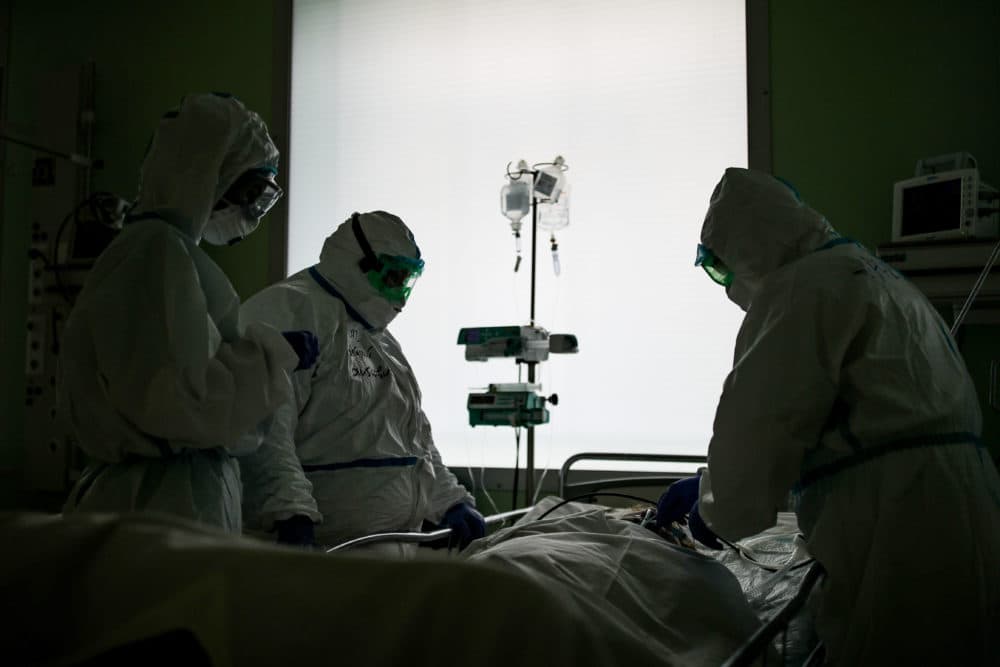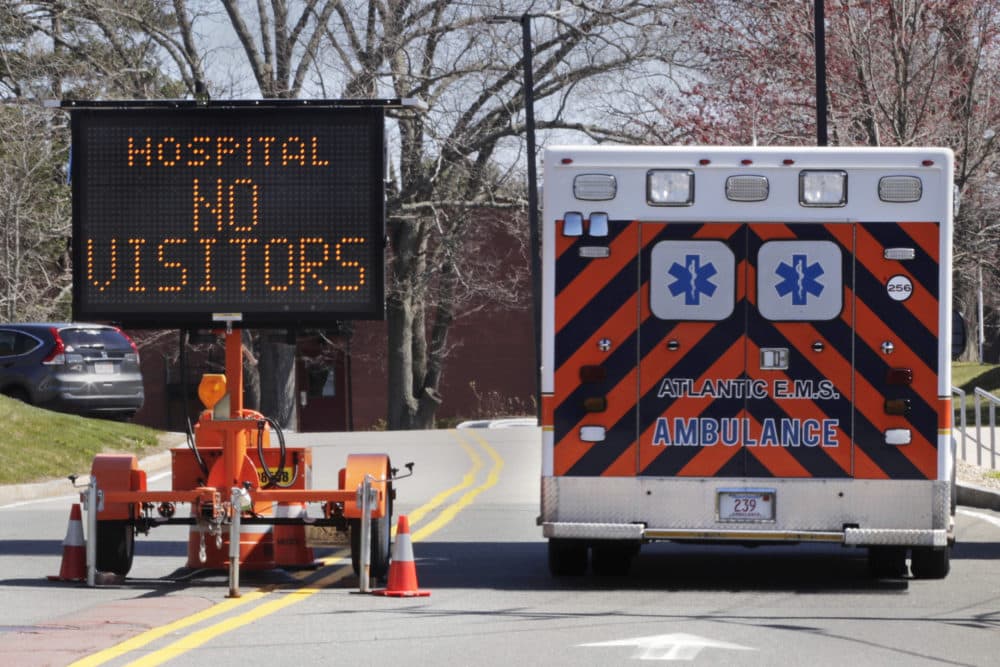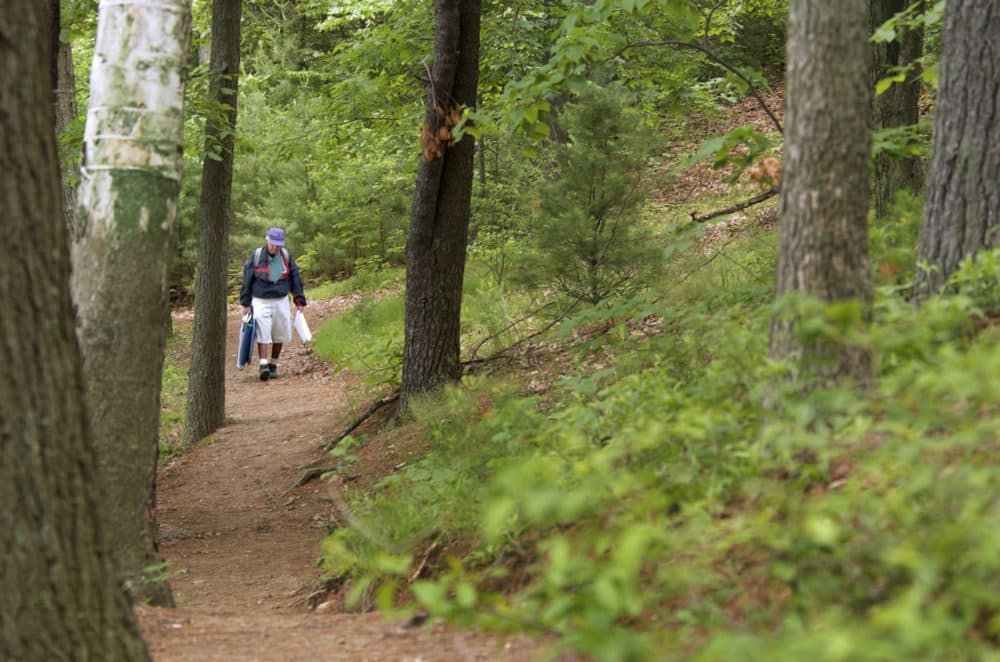Advertisement
Commentary
My Patients Are Sick And Alone. What The Pandemic Can Teach Us All About Intimacy

Last week, on the first properly warm day of spring, my fiancée and I went walking with her parents not far from Walden Pond. We all wore masks, and kept our distance on the trails, but those few hours of walking together boosted our spirits for days afterwards, even though we’ve been having regular Zoom check-ins since the pandemic began.
Was it just the effect of being in a beautiful place together, appreciating the sun sparkling on water, and the clear sky above? Or was it something else that being in proximity gave us that Zoom hadn’t, or couldn’t?
We passed a small beaver pond as we walked, and the grasses and reeds were alive with toadsong. The soft, echoing chorus reminded me of the steady background hum of monitors and alarms in the emergency department where I work as a physician. I thought of the patients we’ve cared for in the hospital, and of how alone they’ve been.

Due to concerns about the coronavirus, visitors have not been allowed in the hospital for weeks now. I’m used to finding spouses, siblings, friends, parents, or sometimes whole families gathered around a patient’s bed. Now, as I make my way around the emergency department, every patient is alone in their room. The same is true for the hundreds of patients on the wards and in the intensive care unit (ICU).
This physical separation is taking a toll on families as well as patients. I’ve heard so many stories of rushed goodbyes as an ambulance crew whisks away a loved one stricken with COVID-19. Some of these goodbyes have been final. Many are also left without a sense of closure — it’s hard to accept the devastating reality that someone isn’t coming home from the hospital, if you were never able to see them there.
Even those who haven’t contracted the virus have been affected by social distancing and isolation from friends and family. Before the pandemic, one in five Americans reported feeling lonely. Among senior citizens, the number was closer to one in two. How much higher are those numbers now?
I worry that, before the pandemic, our reliance on mobile technology was steadily disrupting our ability to form and tend to close physical relationships
Hospitals do sometimes make an exception to their strict no-visitor policies. At Massachusetts General Hospital, where I work, the ICU staff recently made arrangements for the partner of a critically ill patient to visit for a very special occasion — their wedding. The pair had been together for 50 years but never wed. The bride wore a tiara with her mask and surgical gown. On April 23, the hospital chaplain pronounced them man and wife. Two days later, the man died.
But these exceptions are rare, and some have argued that greater reliance on communications technology might be the best way to ease the suffering of our isolated patients. At Mass General, we have iPads mounted on IV poles, and some of us have used our personal cell phones to record messages from patients, before we intubate them, because they aren’t sure if they’ll ever speak again.
Digital surrogates for social contact are certainly better than nothing, and it’s tempting to think that they might even help patients recover. In Missouri, a 65-year-old man was near death from a severe coronavirus infection, and the family was thinking about moving away from aggressive treatment. A nurse held the patient’s cell phone up to his ear so his wife could speak to him. And then, unexpectedly, his health began to improve. His breathing tube came out a week later; the family believes that his wife’s voice made all the difference. They raised $25,000 to buy 70 iPads for the hospital, so other families could better communicate with their loved ones.
Advertisement

Physical proximity, and touch, might be even more powerful. Much has been written about the importance of touch in the healing process, but it’s a difficult phenomenon to study. Stories suggesting a link are everywhere, though.
One of the first COVID-19 patients admitted to our ICU, a healthy and fit 49-year-old lawyer, was profoundly ill and his prospects for recovery were grim. His doctors allowed his wife to visit, thinking it might be the last time she saw him alive. She sat at his bedside, in full PPE, and spoke to him while she held his hand. He was deep in a medically induced coma and couldn’t respond, but within three days he began showing signs of improvement. Eventually, after 32 days on a ventilator, he was finally able to breathe on his own again.
I worry that, before the pandemic, our reliance on mobile technology was steadily disrupting our ability to form and tend to close physical relationships, the kind characterized by physical presence, empathic touch and non-verbal cues like eye contact and facial expression. This way of interacting is so much richer than the digital simulacra that we have chosen as our preferred mode of communication.
Sherry Turkle, a research psychologist at MIT, examined this phenomenon in her book “Alone Together.” “Technology proposes itself as the architect of our intimacies,” she writes, but the reality she discovers in studying our relationships to our mobile devices suggests “substitutions” that, as she says, “put the real on the run.” Turkle documents teenagers and adults who seem averse to face-to-face communication. But despite their constant digital connection, many of those she interviews share a pervasive sense of loneliness and isolation. “When technology engineers intimacy,” Turkle observes, “relationships can be reduced to mere connections. And then, easy connection becomes redefined as intimacy.”
I take a great deal of pleasure in nature’s splendor, but for me the perennial source is human connection, and all of the richness it entails.
Now, with little choice beyond Zoom or FaceTime for social interaction, are we finally feeling the absence of real intimacy? Maybe there’s a silver lining here: maybe we will realize that physical proximity and connection are essential, and finally see what we’ve lost by letting this mode of connection lapse.
“What do we want most to dwell near to?” Thoreau wondered to himself in “Walden,” pondering why loneliness hadn’t yet found him in his small cabin near the pond. He considered the post office, the meeting house, the grocery, the bar room, Beacon Hill. No, it wasn’t any of those particular places, he decided. What we, as humans, want most to dwell near to was something that ran deeper. We want to dwell near the “perennial source of our life,” he wrote, “as the willow stands near the water and sends out its roots in that direction.”

We want to dwell near something essential, that transcends any particular place. But what is the “perennial source?” For Thoreau, at least during his time at Walden, it was nature:
I am no more lonely than a single mullein or dandelion in a pasture, or a bean leaf, or a sorrel, or a horse-fly, or a humble-bee. I am no more lonely than the Mill Brook, or a weathercock, or the north star, or the south wind, or an April shower, or a January thaw, or the first spider in a new house.
But Thoreau only stayed at Walden for a little more than two years before he returned to Concord. Did his idea of what constituted his perennial source shift? Did he miss the intimacy of living in close communion with his friends and neighbors?
I take a great deal of pleasure in nature’s splendor, but for me the perennial source is human connection, and all of the richness it entails. That’s what buoyed my fiancée and me for days after our walk in the woods with her family. With proximity, we could send out roots in each other’s direction.
This segment aired on May 14, 2020.
